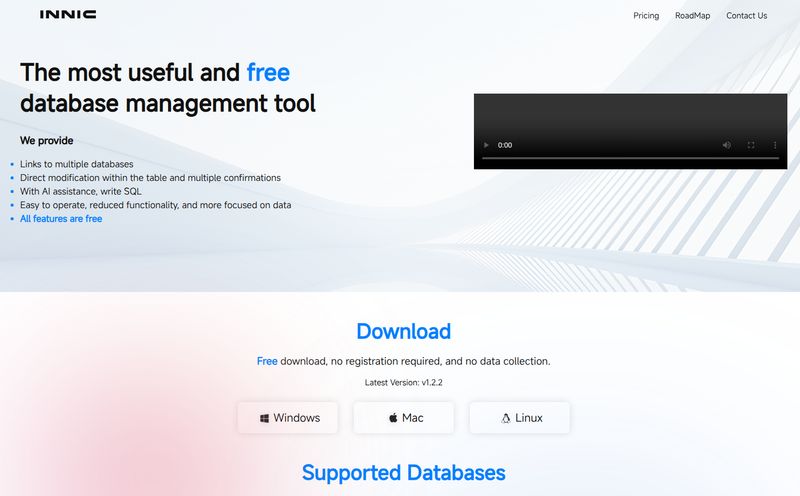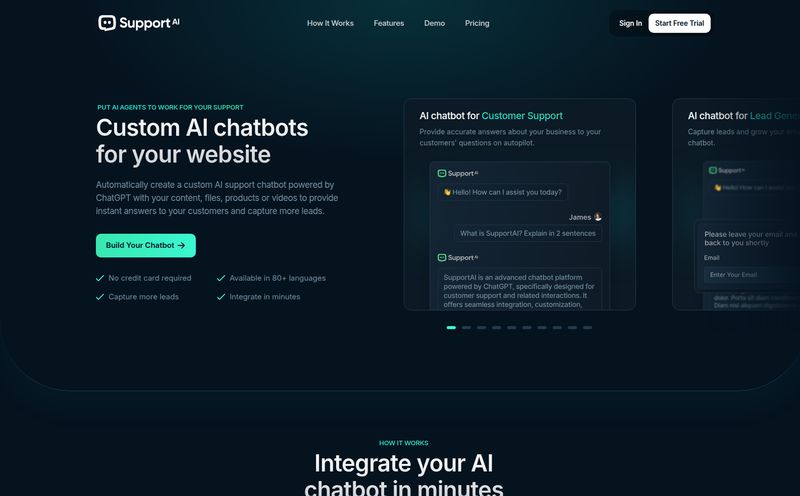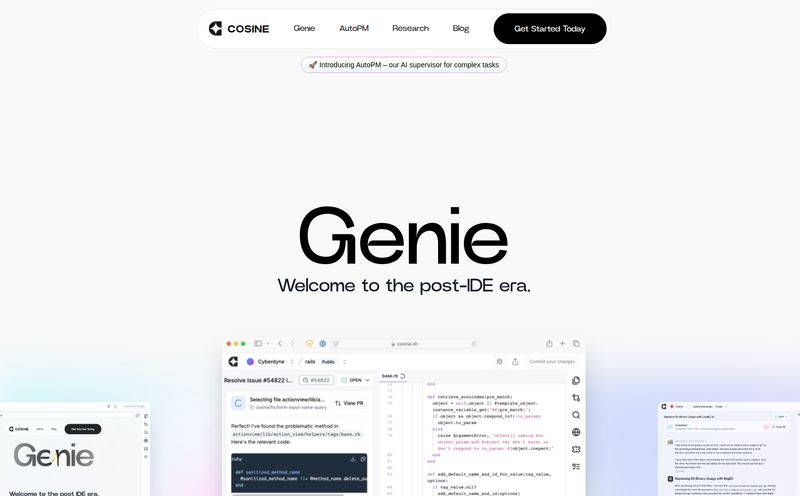If you've ever been in the trenches of software development, you know the grind. Specifically, the API grind. It’s the foundational plumbing of almost every modern application, and yet, building it can feel like laying the same pipes over and over again. You write the boilerplate for CRUD operations, set up the authentication, configure the server, wrestle with infrastructure... it's a ton of work before you even get to the interesting part of your project.
For years, we've had frameworks and tools to speed this up, but it's still largely a manual process. But now, with Generative AI seeping into every corner of the tech world, a new promise is emerging: what if you could just... describe your API and have it built for you? Instantly.
That's the glittering promise of tools like GenAPI. It bills itself as the world's first Generative AI that spins up production-grade APIs from a simple text prompt. An idea-to-endpoint machine. Sounds like magic, right? I thought so too. So I decided to take a look.
So, What is GenAPI Anyway?
At its core, GenAPI aims to be an API architect in a box. The concept is straightforward: you tell the AI what you need—say, an API for a user management system with endpoints for creating, reading, and updating user profiles—and it generates the code, sets up the infrastructure on AWS, and hands you a ready-to-use, scalable API. In minutes.
This isn't just about spitting out some Python or Node.js code. The platform claims to build it all according to the AWS Well-Architected Framework, which is a big deal. That means it’s supposedly designed from the ground up for security, reliability, and cost-efficiency. It's like having a seasoned DevOps engineer on call, but one that works at the speed of light and is powered by prompts.
The Big Promise: Key Features Explored
When you look at the feature list, it’s hard not to get a little excited. It reads like a developer's wish list for a magic wand.
From Text Prompt to Live Endpoint
The main event is, of course, the Generative AI itself. The idea of sidestepping months of development is the huge draw here. For startups racing to build an MVP, or for teams needing to prototype quickly, this could radically change the game. Less time on plumbing means more time on features that users actually see and interact with.
Production-Ready from Day One
GenAPI throws around the term "production-grade" a lot. That's a bold claim. In my book, that means it needs to be secure, reliable, and able to handle real traffic. They back this up by offering things like a 99.99% uptime SLA (for their Enterprise clients, at least) and an architecture that can autoscale to handle millions of requests per second. If true, that's impressive. It removes the entire headache of performance tuning and infrastructure management for scaling.
Source Code and No Lock-in
One of my biggest initial concerns with a tool like this is vendor lock-in. What happens if I want to move away or need to customize something beyond the AI's capabilities? Thankfully, the Pro and Enterprise plans provide full source code access. This is critical. It turns GenAPI from a potential black box into a powerful starting point. You can generate 80% of your API in minutes, then have your team fine-tune the remaining 20% by hand. That’s a powerful workflow.
The Elephant in the Room: I Couldn't Even Get In
Okay, time for some real talk. I was genuinely hyped to try this thing out. I had my prompts ready, my credit card on standby for a potential upgrade. I navigated to genapi.co, and… BAM. Blocked.

Visit GenAPI
Not a 404 error. Not a server down message. A full-on Cloudflare block page telling me, "Sorry, you have been blocked." I tried again. Same thing. I checked from a different network. Still no dice.
The irony is just… thick. A platform promising 99.99% uptime and robust infrastructure to handle millions of requests couldn't handle one request from me to see their homepage. It's like a world-class security firm having a flimsy lock on its own front door. Look, things happen. Maybe their security rules are overly aggressive, maybe it was a temporary glitch. But for a potential customer, it's a jarring first impression and a pretty significant red flag. How can I trust you to build my production infrastructure if I can’t even see your marketing site?
Let's Talk Money: GenAPI Pricing Breakdown
Assuming you can actually access the site, let's talk about the cost. The pricing structure seems pretty logical and caters to different stages of a project's lifecycle. All my information here is based on the data I could find, since their pricing page was behind that digital bouncer.
| Plan | Price | Key Features | My Take |
|---|---|---|---|
| Starter | Free | 1 Project, 10 AI Credits | Perfect for dipping a toe in. You can test the core functionality and see if the AI-generated code is even remotely what you expect. No real risk. |
| Pro | $49 / month | 5 Projects, 100 AI Credits, Serverless or Containers, Source Code, Live Support | This feels like the sweet spot for solo developers, freelancers, and small teams. The price is reasonable, and getting the source code is the killer feature here. |
| Enterprise | Contact Us | 10+ Projects, 250+ AI Credits, Uptime SLA (99.99%), Priority Support | For the big leagues. Companies that need guarantees, dedicated support, and are willing to pay for that peace of mind. The uptime SLA makes this a serious contender for mission-critical apps. |
Overall, the pricing seems fair—if the tool works as advertised. Forty-nine bucks a month to save potentially weeks of development time? That's a no-brainer.
Who Is This Really For?
Despite my access issues, I can see the vision. GenAPI isn't for every single use case, but for a few key groups, it could be a godsend:
- Lean Startups: Need to get an MVP to market yesterday? This is your fast track.
- Frontend Developers: Want to build a full-stack app but the backend is your kryptonite? This could empower you to build complete projects on your own.
- Prototyping Teams: Perfect for larger companies that need to quickly build and test new ideas without tying up their core engineering teams.
- Agencies: Imagine spinning up a robust backend for a client project in an afternoon instead of a week. That's more profit and happier clients.
My Final Thoughts: A Glimmer of the Future, Behind a Locked Door
So, where does that leave us with GenAPI? I'm in a weird spot. On paper, I love it. I'm a huge believer in tools that abstract away the tedious parts of our jobs so we can focus on creativity and innovation. The promise of GenAPI is exactly that—it wants to handle the boring stuff so you can build the cool stuff.
But a promise is only as good as its delivery. The tech sounds incredible, the pricing seems right, and the potential is undeniable. However, the inability to even access their website is a major stumbling block that shakes my confidence.
I'm choosing to be cautiously optimistic. I'll probably try to access their site again in a week or two. Maybe it was just a bad day. Because if they can get their own front door unlocked, they might just hold the key to a much faster way of building software. And that’s a future I'm definitely excited about.
Frequently Asked Questions about GenAPI
- What exactly is GenAPI?
- GenAPI is a platform that uses Generative AI to automatically create and deploy complete, production-ready APIs from text descriptions. It's designed to drastically reduce manual development time and infrastructure setup.
- How does GenAPI create the APIs?
- You provide a natural language prompt describing the API you need (e.g., its purpose, data models, and endpoints). The AI then interprets this prompt to generate the application code and configure the necessary cloud infrastructure on AWS.
- Is GenAPI suitable for large-scale, production applications?
- It claims to be. With features like autoscaling, an AWS Well-Architected foundation, and a 99.99% uptime SLA on its Enterprise plan, it's built with scalability in mind. The ability to get the source code also allows for custom, enterprise-grade modifications.
- Do I own the code that GenAPI creates?
- Yes, if you're on the Pro or Enterprise plan. These tiers provide full source code access, which means you can download it, modify it, and host it wherever you want, freeing you from vendor lock-in.
- What does the GenAPI free plan include?
- The Free Starter plan is meant for trial and small tests. It typically includes the ability to create one project and comes with 10 AI credits to use for generating your API.
- Is GenAPI secure?
- The platform states that it builds APIs on a secure, AWS Well-Architected foundation, which includes best practices for security. However, as with any code generator, you should always review the output and perform your own security audits, especially for sensitive applications.
Reference and Sources
- GenAPI Pricing (Information sourced from provided data as site was inaccessible): https://genapi.co/pricing
- AWS Well-Architected Framework: https://aws.amazon.com/architecture/well-architected/



